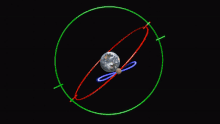Wright State University Lake Campus/2019-1/Phy1060/Notes
Phy1060 (Astronomy)
Click here to learn about the final exam take-home and option in-class test

Syllabus -- Notes -- Pilot-- textbook -- Astronomy college course -- Phy1060/Old studyguide -- slides - wright.miraheze.org
Week 1
editLater: Coriolis effect: https://www.windows2universe.org/teacher_resources/ocean_education/TheOceanInMotion.pdf
1/15 (T) Link to textbook. Exponential notation.
edit- Textbook:We got to https://cnx.org/contents/LnN76Opl@17.1:bRq9BafY@8/Numbers-in-Astronomy
- Student Essay: exponential notation
1/16 (W) Chapter 1: A brief tour
edit- Slides 01: A brief tour
- https://cnx.org/contents/LnN76Opl@17.1:vJqc7PER@11/A-Conclusion-and-a-Beginning
1/17 (R) Chapter 2: Birth of Astronomy
edit- Slides 02: Nighttime sky - Birth of astronomy
- https://www.skyandtelescope.com/observing/stargazers-corner/solar-eclipse-lab-sunny-day/
1/18 (F)
editWeek 2
editMLK off 1/21(M)
1/22 (T) Coriolis force
edit1/23 (W) Slides: 3 Orbits and Gravity
editw:Ptolemy's world map Ch 3 slides gravity
1/24 (R) Newton's dark secrets and intro to calculus
editNewton's Dark Secrets: Slope of a parabola at x=0:
1/25 (F) Newton's dark secrets and exponential growth on a spreadsheet
editFinish Newton and perhaps do exponential growth on a spreadsheet.
Week 3
edit1/28 (M) Ch4 Earth, Moon, and Sky
edit2/1 (F) Ch 5 Radiation and Spectra
editWeek 4
edit2/4 (M) Ch 6 Astronomical Instruments
edit2/5 (T) Ch7 Other Worlds: An Introduction to the Solar System
edit2/8 (F) Strike ends
editWeek 5
edit2/12 (T) Chasing Pluto
edit2/13 (W) Chasing Pluto
edit2/14 (R): Chasing Pluto test
edit2/15 (15): Ch8 Earth as a Planet
editWeek 6
edit2/18 (M) Ch 9 Cratered Worlds
editGot to page 13
2/19 (T)
edit2/20 (W)
edit2/21 (R)
edit2/22 (F)
editWeek 7
edit2/25 (M)
edit2/26 (T)
edit2/27 (W)
edit2/28 (R)
edit3/1 (F)
editChapter 19
Spring Break
editNo classes 3/4(M)-3/9(S)
Week 9
edit3/11 (M) Ch20 & Computers
edit3/12 (T)
editI will allow contributions to the following Symposium to replace all or part your exam scores. If it replaces final exam, you must do work after the last day of class. Chapter 21
Symposium
edit- Students interested in presenting a poster that presents new numerical questions using Python, Excel, Matlab are encouraged to submit a poster. I will help you with the details.Guy vandegrift (discuss • contribs) 18:57, 11 March 2019 (UTC)
- https://lake.wright.edu/research/research-symposium
- The symposium will be held in Dicke Hall on Thursday April 18, 2019 from 11:00am to 1:30pm. * Refreshments will be provided.
- If you would like to present at this year’s symposium please RSVP your project title, author names, and brief abstract to stephen.jacquemin@wright.edu by the end of the day on Monday March 25, 2019 for inclusion in the program.
3/13 (W)
edit3/14 (R) Quiz
editQuiz:
click to view
|
|---|
|
|
3/15 (F)
editWeek 10
edit3/18 (M)
edit3/19 (T)
editChapter 23 death of stars
3/20 (W)
edit3/21 (R)
edit3/22 (F)
editWeek 11
edit3/25 (M)
edit3/26 (T)
edit3/27 (W)
edit3/28 (R)
edit3/29 (F)
editPlayed with the two experiments: simultanaety and spray diagrams 2d
Week 12
edit4/1 (M)
edit4/2 (T)
edit4/3 (W)
edit4/4 (R)
edit4/5 (F)
editWeek 13
edit4/8 (M)
editLab: Drake's equation
- Make a sketch showing why N = RL where R is the rate of formation and L is the lifetime.
- Do an excel spreadsheet showing how f=f1f2f3 for two coins and one dice. Verify the approximation that the standard deviation of S is where N is the number of attempts, and S=Nf is the number of successes.
4/9 (T)
edit4/10 (W)
edit4/11 (R)
edit- Borodin, Alexander: string quartet No. 2 in D, 3rd movement
- https://www.youtube.com/watch?v=IhP1GnAvm0w
4/12 (F)
edit

https://physics.weber.edu/schroeder/ua/default.html w:Celestial_spheres and w:
Week 14
edit4/15 (M)
editThis alleviates most of my skepticism about the black hole.
4/16 (T)
edit4/17 (W)
edithttps://phys.org/news/2019-04-variations-fogginess-universe-milestone-cosmic.html
4/18 (R)
edit4/19 (F)
editWeek 15
editLast day of classes is 4/27(S)
4/22 (M)
editDiscussed fina. See below.
4/23 (T)
edit4/24 (W)
editblack hole - Elsewhere - World line
4/25 (R)
editcontinue with above.
4/26 (F)
edithttps://www.livescience.com/65300-hawking-black-hole-theory-unlikely.html
Astronomy_Final_Exam_2019
editTakehome final exam for all, in class final for some
- Details will be announced on Wikiversity on Friday 26 April. These details will include what grade you will get if you don't take the final exam multiple choice test on Wednesday 1 May 1-3 pm. You will be informed by Pilot before Friday.
- Regardless of whether you take the final exam, you must submit 10-15 exam questions. This is required by all students, but not all students are required to take the final exam on Wednesday 1 May from 1-3pm.
- Attach a pdf, word, or excel document to an email to guy.vandegrift@wright.edu
- You are encouraged to include short explanations. If you have "poor" or unfinished questions already typed up, don't hesitate to include them as well.
4/29 (M)
edit2:00 PM deadline for submitting preliminary version of takehome. Email it to guy.vandegrift@wright.edu
4/30 (T)
editI will be off-campus all day, but plan to email you with a tentative grade, with suggestions on how to improve it by either adding more questions, or taking the final exam.
5/1 (W)
editFinal exam is Monday 1 May for those who wish to take it. A study guide can be found at this link:
Wright_State_University_Lake_Campus/2019-1/Phy1060/Old_studyguide#FE_Monday_1_May_2019
5/2 (R)
editI will be available for most of the day.
5/3 (F)
edit11:59 PM deadline for submitting final version of the takehome.


